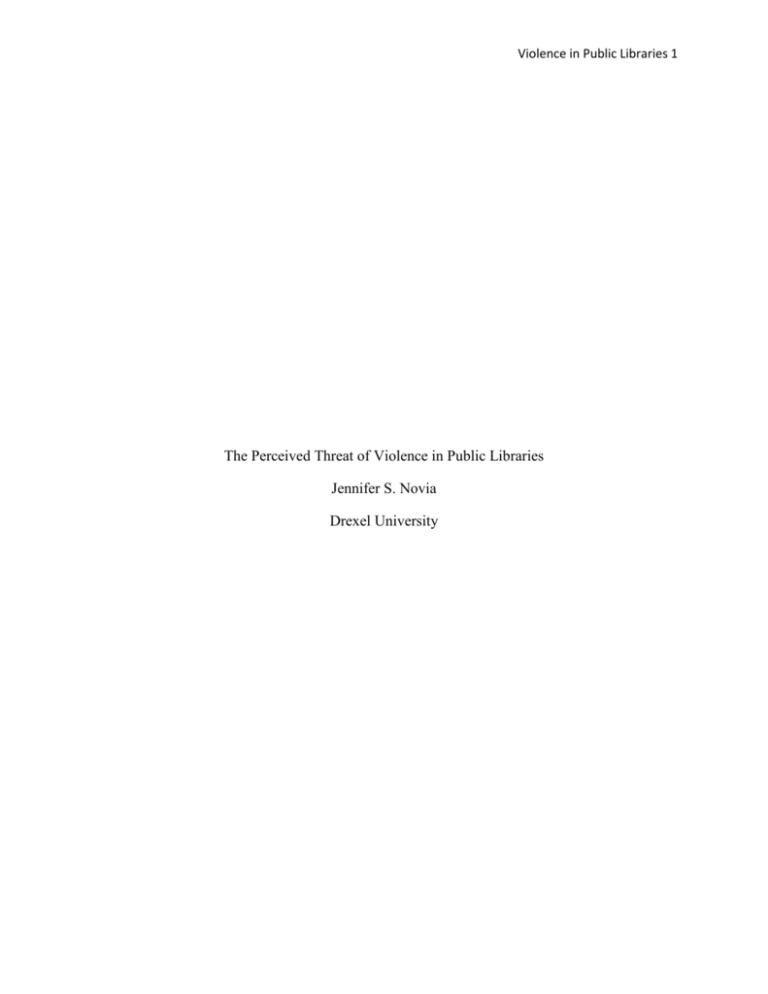
Violence in Public Libraries 1
The Perceived Threat of Violence in Public Libraries
Jennifer S. Novia
Drexel University
Violence in Public Libraries 2
Introduction
According to “Violence in the Workplace”, 1.74 million violent crimes took place in the
workplace in each year between 1993 and 1999 (U.S. Department of Justice, 2001). Of those
crimes, it is approximated that there is an annual rate of 900 homicides per year in the workplace
which works out to 2.4 fatal homicides a day in the workplace. The greater part of incidents are
perpetrated by strangers and are customarily cases of assault, stalking, harassment, sexual
crimes, and other abuses that do not make for sensational news headlines.
It is hypothesized that public libraries are vulnerable to acts of violence because of their
tendency to have an open-door policy to patrons from all walks of life (Pease, 30). The purpose
of this paper is to provide a review of violence and the potential for violence in public libraries.
It will also provide an outline of recommendations to improve overall safety and compliance.
Service Philosophy
Historically, the public library is considered a bastion of peace, a place for quiet
reflection and study. In 1939, The Library Bill of Rights was adopted and expressed the ideal
that public libraries be open to all patrons free of charge (Pease, 30). Pease (1995, p.32) and
Lifer (1994, p. 35) cited a study conducted from 1981 to 1983 that led the researcher, Jay
Lincoln, to conclude that the more public access to a facility, the more apt it is to be exposed to
criminal or violent acts.
History of Violence in Libraries
Workplace violence is an all-encompassing term. Because cases of violence in libraries
are so seldom reported and usually not of an extreme nature, the topic is not breached as often as
it should be. It has been a common opinion that management in libraries avoids the issues of
violence in our public libraries thus making it the vocation’s “skeleton in the closet” (McGrath
Violence in Public Libraries 3
and Goulding, 1996). Violence happens on a more personal nature because in an environment
such as a library the offending acts are committed by one person acting against another through
intimidation or abuse. In 1981, it was discovered by one library director that the majority of
violent occurrences experienced in the library environment were the direct result of mental
violence such as vulgar language, bad behavior and the fear of acts or threats of vandalism
(Pease, 1995).
Definition of a “Problem” Patron
Problem patrons have become a part of the landscape at libraries since they have their
doors open to users of any age or social standing. Any patron has the capacity to become a
problem in the library by choosing not to follow the rules however the issues goes much deeper
than that. Brashear, Maloney, and Thorton-Darringe (1981, p. 344) identified three
classifications of problem patrons: harmless nuisances, disruptive or threatening, and violent.
The harmless nuisance may be the patron who comes into the library reeking of strong,
offensive body odor. Simply put, a harmless nuisance can be the patron in the library who
dominates the librarian’s time or references.
Those patrons who are disruptive or threatening may be the alcoholic or drug users who
have wandered in off the street. Confrontations with these often unstable individuals hold the
potential to escalate into a violent situation quickly. In a study conducted in the United Kingdom
in 2001, 69 percent of those who responded indicated that they had been exposed to verbal abuse
at work whereas only 5 percent had experienced physical abuse or sexual abuse (Farrugia, 2001
cited in Farrugia, 2002, p. 316). Young people have also become a problem in libraries as they
tend to congregate in public areas that will not turn them away. Their behavior may begin as
disruptive whispering or talking but progress to indignation when told to quiet down.
Violence in Public Libraries 4
Truly violent patrons commit acts such as murder, sexual crimes, arson, bomb threats,
and assault against librarians and patrons alike. Although cases of murder are rare in public
libraries, they do occur. Between 1992 and 2000, there were five incidences of murder in
libraries across the United States. Two of these murders involved the sexual assault or
harassment of the librarian who was killed (Wellinger, 1997; Shuman, 1999; American Library
Journal, 2001 cited in Farrugia, 2002, p. 310).
Recommendations for Dealing with Violence
Pease (1995) states that, “The enemy is us.” Because librarians are trained to have a high
tolerance level for social differences in behavior it is believed that they lack the wherewithal to
be disciplinarians. The first recommendation is that librarians be provided assertiveness training
in addition to formal training. Assertiveness training trains librarians how to diffuse a potential
powder keg when dealing with a difficult patron. If a problem patron feels that they are able to
behave poorly and get away with it because the librarian cannot assert his or her authority, the
behavior will increase and get worse.
It is imperative that libraries post written behavior guidelines for patrons to view.
Because of the basic philosophy of the library to allow free access to all, these policies must be
able to stand up to legal scrutiny if challenged. In Brinkmeier v. City of Freeport, a man who was
removed from the library because of sexual transgressions was able to legally argue that his First
Amendment rights were violated. The court found in his favor because the policies for behavior
were vague and largely unwritten (McNeil and Johnson, 1996 cited in Farrugia, 2002, p. 312).
Risk can be managed by various means. Physical security can be provided by a security
officer however this level of protection is rarely used because of the relatively rare incidence of
violent crime in libraries. Many libraries have installed alarms which include panic buttons and
Violence in Public Libraries 5
personal alarms that can be activated by a librarian who might happen to be working alone or in
a remote part of the library.
Summary and Conclusion
Although it is uncommon for heinous acts of violence to occur in public libraries, there is
the underlying risk of threats and abuse by problem patrons. This paper highlights the history of
workplace violence, librarianship as a service industry, and an explanation of what a problem
patron is. In addition to this, a basic recommendation to increase the disciplinary atmosphere and
safety of librarians has been explored.
In an occupation that is viewed by many as docile, librarians must take the reins and
protect themselves and patrons in their charge. While the actions of others may not be
predictable, the addition of training, succinct written policies, and improved security practices
can once again make the public library a safe haven.
Violence in Public Libraries 6
BIBLIOGRAPHY
Brashear, J., Maloney, J., Thorton-Darringe, J. (1981). Problem patrons: the other kind
of library security. Illinois Libraries, 63(1), 344
Farrugia, S. (2002). A dangerous occupation? Violence in public libraries. New Library
World, 103(9), 309-319
St. Lifer, E. (1994). How Safe Are Our Libraries? Library Journal, 119(13), 35-39
McGrath H., and Goulding A. (1996). Part of the job: Violence in public libraries. New
Library World, 97(1127), 4
Pease, B. (1995). Workplace violence in libraries. Library Management, 16(7), 30-40
Bureau of Justice Statistics. (2001). Violence in the Workplace, 1993-1999. Special
Report, U.S. Department of Justice, Office of Justice Programs, NCJ 190076





